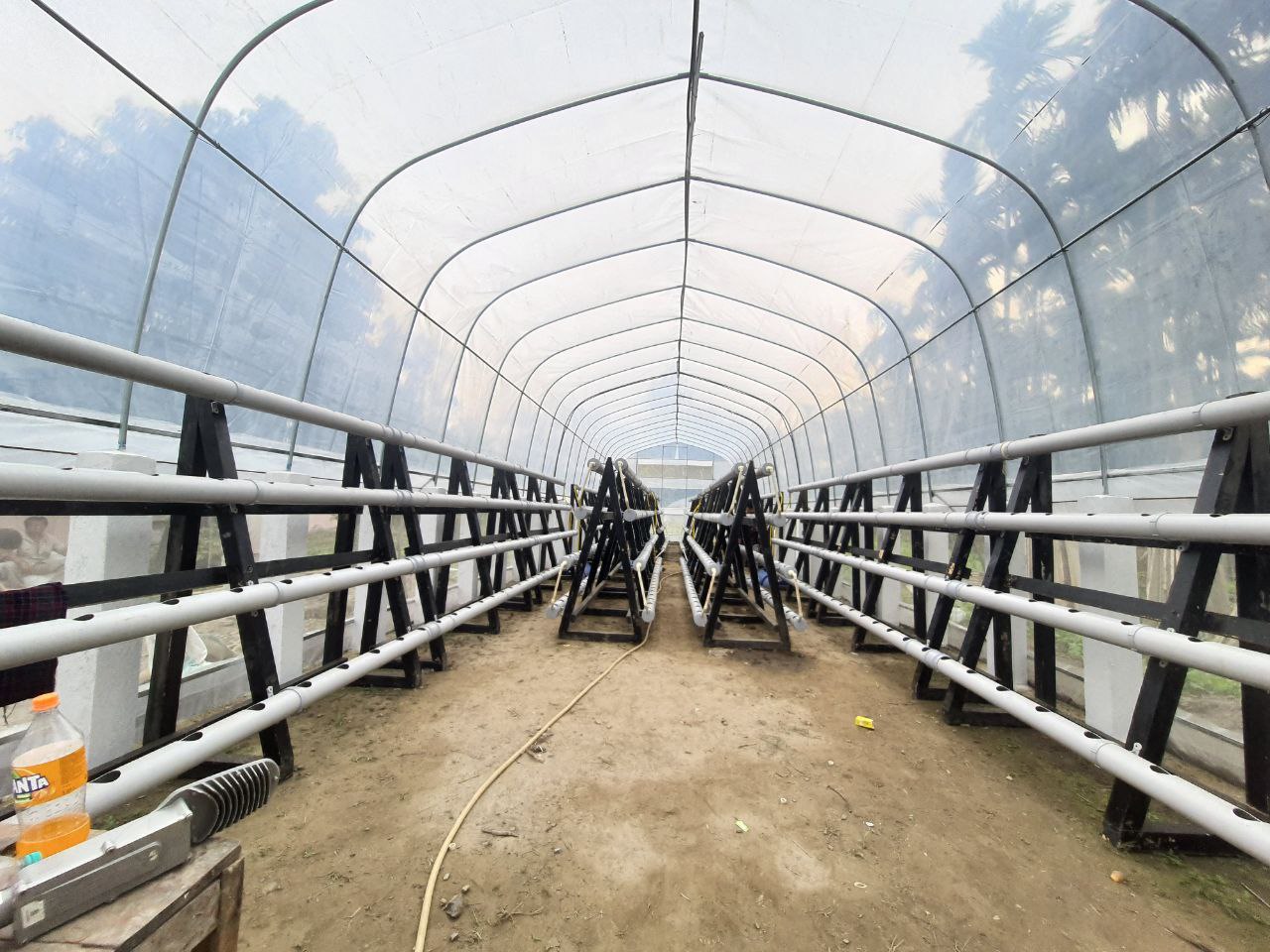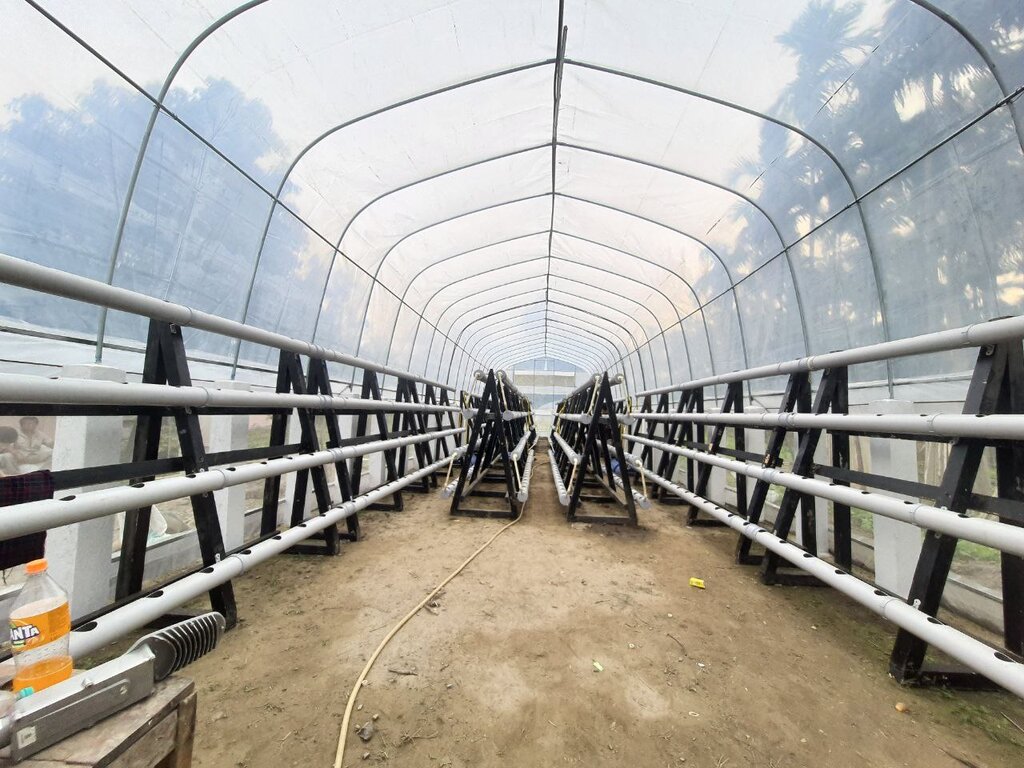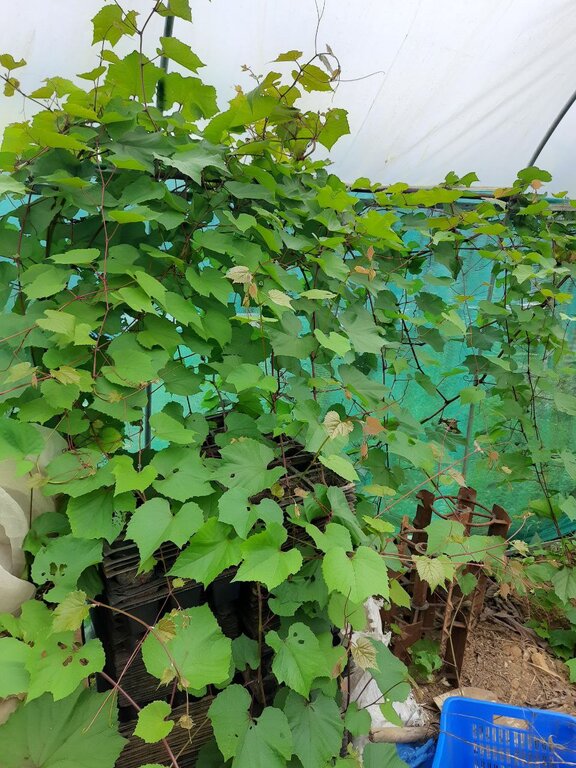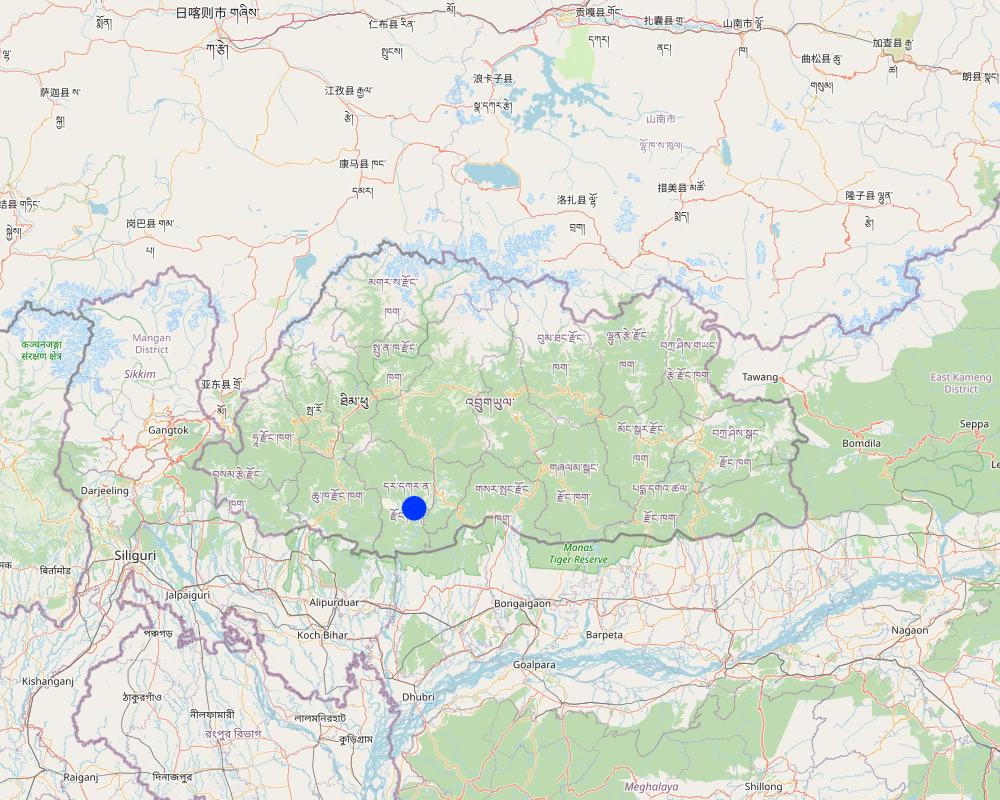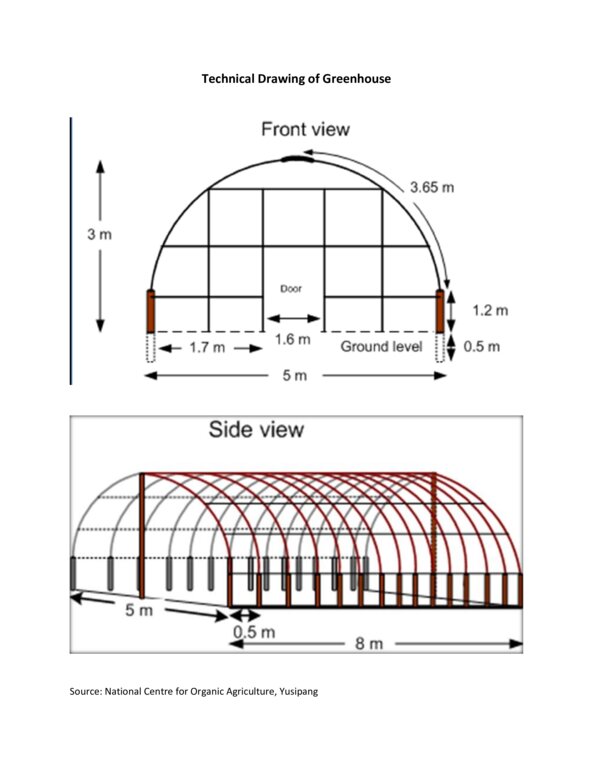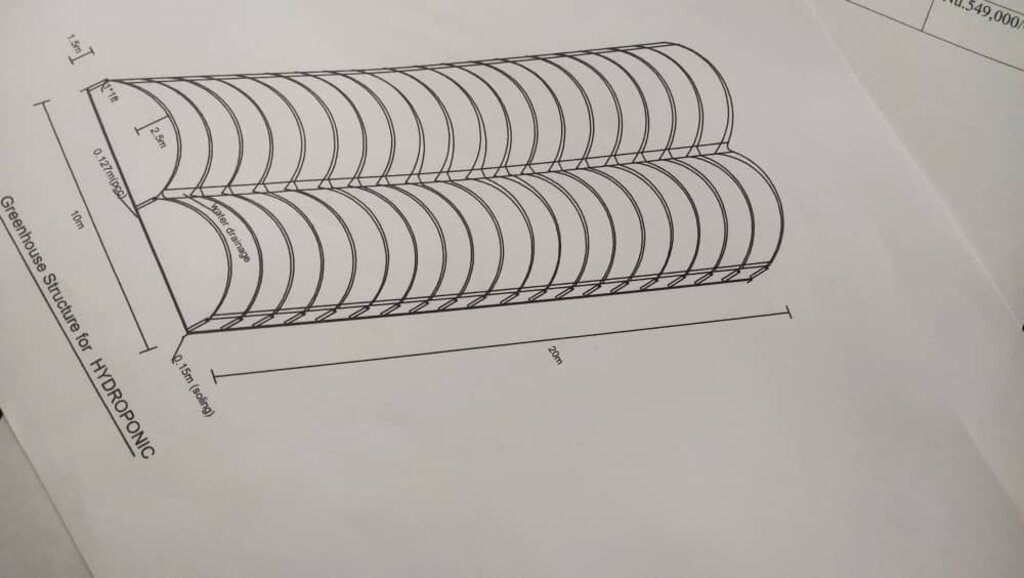Protected Agriculture for High Value Crops [Butão]
- Criação:
- Atualização:
- Compilador/a: Nima Dolma Tamang
- Editor: Haka Drukpa
- Revisores: William Critchley, Rima Mekdaschi Studer
technologies_6846 - Butão
Veja as seções
Expandir tudo Recolher tudo1. Informação geral
1.2 Detalhes do contato das pessoas capacitadas e instituições envolvidas na avaliação e documentação da tecnologia
Pessoa(s) capacitada(s)
usuário de terra:
Narayan Abi
Abimanyum Farm
Butão
Nome do projeto que facilitou a documentação/avaliação da Tecnologia (se relevante)
Strengthening national-level institutional and professional capacities of country Parties towards enhanced UNCCD monitoring and reporting – GEF 7 EA Umbrella II (GEF 7 UNCCD Enabling Activities_Umbrella II)Nome da(s) instituição(ões) que facilitou(ram) a documentação/ avaliação da Tecnologia (se relevante)
National Soil Services Centre, Department of Agriculture, Ministry of Agriculture & Livestock (NSSC) - Butão1.3 Condições em relação ao uso da informação documentada através de WOCAT
O compilador e a(s) pessoa(s) capacitada(s) aceitam as condições relativas ao uso de dados documentados através do WOCAT:
Sim
1.4 Declaração de sustentabilidade da tecnologia descrita
A tecnologia descrita aqui é problemática em relação a degradação da terra de forma que não pode ser declarada uma tecnologia de gestão sustentável de terra?
Não
1.5 Referência ao(s) questionário(s) sobre abordagens GST (documentado(s) usando WOCAT)
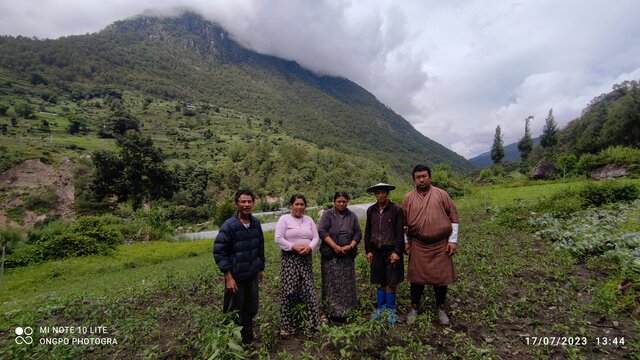
Enhancing Agricultural Production Through Fallow Land Reversion [Butão]
The approach is to enhance production of local vegetables and fruits through fallow land restoration - under a group established for the purpose.
- Compilador/a: Nima Dolma Tamang
2. Descrição da tecnologia de GST
2.1 Descrição curta da tecnologia
Definição da tecnologia:
Protected agriculture (controlled environment agriculture) is the use of technology to modify the growing environment for crops to extend the growing period and increase yields. It can include greenhouses, shade nets or polytunnels. This technology is moderately expensive therefore it is used only for the cultivation of high-value crops and raising seedlings in winter.
2.2 Descrição detalhada da tecnologia
Descrição:
Protected agriculture, also known as controlled environment agriculture, refers to the practice of growing crops within an enclosed structure that provides controlled environmental conditions. There are various structures that can be employed, such as greenhouses, shade nets, polytunnels and glasshouses. This documentation focuses on greenhouses. These are commonly used for cultivating high-value crops that yield a higher economic return per unit area compared to traditional field crops. Technical specification for a 20 m x 5 m greenhouse set consists of a galvanized tubular frame, two doors, UV stabilized 120 GSM cross-laminated clear plastic sheet, channels and a nylon belt for holding the plastic sheet. Construction activities include clearing, levelling the ground and ensuring drainage. Installation of water lines, electrical connections, heating systems and ventilation systems is required.
Greenhouses are typically designed with a framework made of materials like metal, wood, or PVC. The structure must be sturdy enough to support covering materials and withstand environmental loads such as wind and snow. Coverings are transparent or translucent materials that allow sunlight to enter the structure. Common options include glass, polycarbonate panels, or plastic film. The choice of covering material depends on factors such as light transmission, insulation properties, durability, and cost. Greenhouses require adequate ventilation to control temperature, humidity, and air circulation. Vents, louvres, or roll-up side walls can be used to regulate airflow and prevent heat buildup. Exhaust fans or natural ventilation methods help remove excess heat, humidity, and carbon dioxide from the structure. Efficient irrigation systems, such as drip irrigation, and micro-sprinklers, are used to deliver water directly to plants' root zones. Raised beds of 1.2 m width and 30 cm height and planting distance of 60 cm are applied for (for example) watermelon.
Greenhouses allow for the cultivation of plants throughout the year, regardless of the external weather. By maintaining a stable and favourable climate inside, growers can start plants earlier in the spring, extend the growing season into the fall, or even grow plants year-round in certain regions. It shields plants from adverse weather conditions such as frost, heavy rain, wind, or hail, which can damage or destroy crops. Greenhouses provide a physical barrier that safeguards plants from external threats, minimizing the risk of disease, pests, and other environmental stresses.
Greenhouses provide a range of benefits and impacts, including increased food production by extending the growing season and improving food security. They produce higher crop yields by providing optimal growing conditions and conserving water through efficient irrigation systems. Greenhouses also contributes to reduced pesticide use, energy efficiency, local and seasonal produce, employment opportunities, research and innovation, and serves as an attractive space for recreation and education. Overall, greenhouses offer sustainable and efficient solutions for agriculture while enhancing environmental stewardship and community well-being.
Protected agriculture through the use of greenhouses offers land users the ability to control environmental factors, leading to optimal conditions for plant growth and higher crop yields compared to open-field cultivation. It protects from adverse weather conditions, reducing crop losses due to frost, rain, or wind. Additionally, the controlled environment minimizes the risk of pests and diseases, resulting in fewer losses and reduced reliance on pesticides. Overall, greenhouses enhance productivity, profitability, and sustainability for land users. On the other hand, setting up a greenhouse requires a significant initial investment, including the construction or purchase of the structure, equipment, and environmental control systems. Operating a greenhouse involves ongoing costs for utilities, maintenance, and replacement of equipment, which can impact profitability. The cost can be reduced by establishing a low cost greenhouse with locally available materials such as bamboo.
2.3 Fotos da tecnologia
2.4 Vídeos da tecnologia
Comentários, breve descrição:
https://www.youtu.be/i8izu3PmQRE
This link provides poly house construction basics video prepared by ARDC Bajo officials and JICA experts of Integrated Horticulture Promotion Project
Data:
01/11/2020
Localização:
Agriculture Research and Development Sub Centre Tsirang
Nome do cinegrafista:
JICA Experts and ARDC Bajo Officials
2.5 País/região/locais onde a tecnologia foi aplicada e que estão cobertos nesta avaliação
País:
Butão
Região/Estado/Província:
Dagana Dzongkhag
Especificação adicional de localização:
Tsendagang Gewog
Especifique a difusão da tecnologia:
- Aplicado em pontos específicos/concentrado numa pequena área
O(s) local(is) tecnológico(s) está(ão) localizado(s) em uma área permanentemente protegida?
Não
Comentários:
It is leased land and does not fall under a permanently protected area.
Map
×2.6 Data da implementação
Indique o ano de implementação:
2020
2.7 Introdução da tecnologia
- Through other farmers
3. Classificação da tecnologia de GST
3.1 Principal/principais finalidade(s) da tecnologia
- Melhora a produção
- Reduzir riscos de desastre
- Atenuar a mudanças climáticas e seus impactos
- Criar impacto econômico benéfico
- To improve livelihood
3.2 Tipo(s) atualizado(s) de uso da terra onde a tecnologia foi aplicada
Uso do solo misturado dentro da mesma unidade de terra:
Sim
Especificar o uso misto da terra (culturas/ pastoreio/ árvores):
- Agrofloresta

Terra de cultivo
- Cultura anual
- Cultura perene (não lenhosa)
- Cultura de árvores e arbustos
Cultivo anual - Especificar culturas:
- Legumes e leguminosas - feijão
- legumes - melão, abóbora ou aboborinha
- legumes - outros
- Chilli
Cultivo perene (sem lã) - Especificar culturas:
- banana/planta/abacá
- culturas florais - perenes
Cultivo de árvores e arbustos - Especificar culturas:
- frutos secos (castanhas do Brasil, pistache, nozes, amêndoas, etc.)
Número de estações de cultivo por ano:
- 2
O cultivo entre culturas é praticado?
Sim
Em caso afirmativo, especifique quais são as culturas intercultivadas:
Watermelon and zucchini are intercropped
O rodízio de culturas é praticado?
Sim
Caso afirmativo, especifique:
Watermelon is followed by chilli or beans cultivation on the same land
3.3 O uso do solo mudou devido à implementação da Tecnologia?
O uso do solo mudou devido à implementação da Tecnologia?
- Sim (Por favor, preencha as perguntas abaixo com relação ao uso do solo antes da implementação da Tecnologia)
Uso do solo misturado dentro da mesma unidade de terra:
Não

Floresta/bosques
- Florestas/bosques (semi)naturais
- Natural forest
As árvores especificadas acima são decíduas ou perenes?
- perene
Comentários:
The land is a cleared settlement from indigenous subtropical forest. Land use changed from subtropical forest to the agroforestry system where few native trees were retained with fruit trees and crops cultivated.
3.4 Abastecimento de água
Abastecimento de água para a terra na qual a tecnologia é aplicada:
- Irrigação completa
Comentários:
Protected agriculture - especially greenhouses - depends on full irrigation with a drip irrigation system.
3.5 Grupo de GST ao qual pertence a tecnologia
- sistema rotativo (rotação de culturas, pousios, cultivo itinerante)
- variedades vegetal/raças de animais melhoradas
- Gestão de irrigação (inclusive abastecimento de água, drenagem)
3.6 Medidas de GST contendo a tecnologia

Medidas agronômicas
- A1: cobertura vegetal/do solo
- A2: Matéria orgânica/fertilidade do solo

Medidas estruturais
- S1: Terraços
- S11: Outros

Medidas de gestão
- M1: Mudança no tipo de uso da terra
Comentários:
For the introduction of the technology, excavated or cut-and-fill bench terraces were built to install greenhouses.
3.7 Principais tipos de degradação da terra abordados pela tecnologia

Erosão do solo pela água
- Wt: Perda do solo superficial/erosão de superfície

Erosão do solo pelo vento
- Et: Perda do solo superficial

Degradação biológica
- Bc: redução da cobertura vegetal
- Bp: aumento de pragas/doenças, perda de predadores

Degradação da água
- Hs: mudança na quantidade de água de superfície
3.8 Redução, prevenção ou recuperação da degradação do solo
Especifique o objetivo da tecnologia em relação a degradação da terra:
- Prevenir degradação do solo
4. Especificações técnicas, implementação de atividades, entradas e custos
4.1 Desenho técnico da tecnologia
Especificações técnicas (relacionada ao desenho técnico):
The technical drawing provided is for the low-cost greenhouse (Made up of bamboo). Generally, the length of a commercial greenhouse is 10 or 20 m and the width of 5 m. The greenhouse can be modified based on the crop to be cultivated. Additional facilities such as drip irrigation set, blower, fan, cooling pad and exhaust fan, temperature sensors are added modify the environment.
Autor:
National Centre for Organic Agriculture, Yusipang
Especificações técnicas (relacionada ao desenho técnico):
Technical details for setting up 5m by 20m double poly house protected structure
Autor:
ARDC Bajo
Data:
01/07/2020
4.2 Informação geral em relação ao cálculo de entradas e custos
Especifique como custos e entradas foram calculados:
- por área de tecnologia
Indique o tamanho e a unidade de área:
3.75 acres
Outro/moeda nacional (especifique):
Ngultrum (Nu.)
Se for relevante, indique a taxa de câmbio do USD para moeda local (por exemplo, 1 USD = 79,9 Real): 1 USD =:
79,0
Indique a média salarial da mão-de-obra contratada por dia:
500
4.3 Atividades de implantação
| Atividade | Periodicidade (estação do ano) | |
|---|---|---|
| 1. | Clearing of vegetations | Winter |
| 2. | Agriculture land development | Winter |
| 3. | Field preparation | Winter |
| 4. | Installation of greenhouse and other structure | Winter |
| 5. | Sowing and plantation of crops and fruits (especially late winter crops) | Winter |
Comentários:
The installation of a greenhouse can be done in any season. However, the most preferred time for the installation is in winter when the crops standing in the field are minimal and the land users are not involved in other farming activities such as paddy cultivation.
4.4 Custos e entradas necessárias para a implantação
| Especifique a entrada | Unidade | Quantidade | Custos por unidade | Custos totais por entrada | % dos custos arcados pelos usuários da terra | |
|---|---|---|---|---|---|---|
| Mão-de-obra | Farm establishment | Number | 30,0 | 500,0 | 15000,0 | 100,0 |
| Mão-de-obra | Installation of structure and plantation | Number | 15,0 | 500,0 | 7500,0 | 100,0 |
| Equipamento | Excavator (farm establishment) | Number of days | 12,0 | 24000,0 | 288000,0 | 100,0 |
| Equipamento | Power tiller | Per hour | 16,0 | 250,0 | 4000,0 | 50,0 |
| Material vegetal | Dragon fruit | Per sapling | 300,0 | 50,0 | 15000,0 | |
| Material vegetal | Watermelon seed | Per packet | 1,0 | 2700,0 | 2700,0 | |
| Material de construção | Greenhouse | Number | 6,0 | 80000,0 | 480000,0 | 20,0 |
| Material de construção | Dragon fruit staking | Number | 39,0 | 700,0 | 27300,0 | 100,0 |
| Custos totais para a implantação da tecnologia | 839500,0 | |||||
| Custos totais para o estabelecimento da Tecnologia em USD | 10626,58 | |||||
Se o usuário da terra arca com menos que 100% dos custos, indique quem cobre os custos remanescentes:
Royal Government of Bhutan (RGoB)
Comentários:
For a greenhouse it costs Nu. 80000. Therefore, the total cost of six green houses that are available at the farm is Nu. 480000 (USD 5790). For the greenhouse, 80% is borne by the RGoB. However, for the overall establishment major costs were borne by the land user and a minimal cost was part of the subsidy/fund support from RGoB as shown in the table above. The land user has 4.9 acre of which 3.75 acre is cultivated and 0.11 acre is under protected agriculture.
4.5 Atividades recorrentes/manutenção
Comentários:
The land user haven't carry out any maintenance due to the recent establishment of the farm. However, there is likely to have a maintenance cost of Nu. 5000 (USD 289) for the greenhouses and overall recurrent cost of Nu. 41975 (USD 506) per annum.
4.6 Custos e entradas necessárias pata a manutenção/atividades recorrentes (por ano)
Comentários:
No maintenance has been carried out
4.7 Fatores mais importantes que afetam os custos
Descreva os fatores mais determinantes que afetam os custos:
Infrastructure and machinery.
5. Ambiente natural e humano
5.1 Clima
Precipitação pluviométrica anual
- <250 mm
- 251-500 mm
- 501-750 mm
- 751-1.000 mm
- 1.001-1.500 mm
- 1.501-2.000 mm
- 2.001-3.000 mm
- 3.001-4.000 mm
- > 4.000 mm
Zona agroclimática
- Subúmido
The area falls under a humid subtropical and warm subtropical zone among the six agro-ecological zones of Bhutan.
5.2 Topografia
Declividade média:
- Plano (0-2%)
- Suave ondulado (3-5%)
- Ondulado (6-10%)
- Moderadamente ondulado (11-15%)
- Forte ondulado (16-30%)
- Montanhoso (31-60%)
- Escarpado (>60%)
Formas de relevo:
- Planalto/planície
- Cumes
- Encosta de serra
- Encosta de morro
- Sopés
- Fundos de vale
Zona de altitude:
- 0-100 m s.n.m.
- 101-500 m s.n.m.
- 501-1.000 m s.n.m.
- 1.001-1.500 m s.n.m.
- 1.501-2.000 m s.n.m.
- 2.001-2.500 m s.n.m.
- 2.501-3.000 m s.n.m.
- 3.001-4.000 m s.n.m.
- > 4.000 m s.n.m.
Indique se a tecnologia é aplicada especificamente em:
- Não relevante
5.3 Solos
Profundidade do solo em média:
- Muito raso (0-20 cm)
- Raso (21-50 cm)
- Moderadamente profundo (51-80 cm)
- Profundo (81-120 cm)
- Muito profundo (>120 cm)
Textura do solo (solo superficial):
- Grosso/fino (arenoso)
Textura do solo (>20 cm abaixo da superfície):
- Grosso/fino (arenoso)
Matéria orgânica do solo superficial:
- Alto (>3%)
Caso disponível anexe a descrição completa do solo ou especifique as informações disponíveis, p. ex. tipo de solo, PH/acidez do solo, nitrogênio, capacidade de troca catiônica, salinidade, etc.
Moisture content 3.31%, organic matter 5.03%, organic carbon 2.92%, pH 5.67, electrical conductivity 337.67 µs/cm, nitrogen 0.15%, phosphorus 0.09 ppm, potassium 123.07 mg/100ml, texture sand clay loam.
The soil analysis was conducted at the Science Laboratory of College of Natural Resources, Royal University of Bhutan, Lobesa, Punakha.
The soil data shared under the section 5.2 is for the growing media used inside the greenhouse. Land user adds organic manure to the existing topsoil which is used as a growing media.
5.4 Disponibilidade e qualidade de água
Disponibilidade de água de superfície:
Médio
Qualidade da água (não tratada):
Água potável precária (tratamento necessário)
A qualidade da água refere-se a:
água de superfície
A salinidade da água é um problema?
Não
Ocorre inundação da área?
Não
Comentários e outras especificações sobre a qualidade e a quantidade da água:
There is a water shortage during the winter season.
5.5 Biodiversidade
Diversidade de espécies:
- Médio
Diversidade de habitat:
- Médio
Comentários e outras especificações sobre biodiversidade:
The species and habitat diversity in the questions above are referred to the farm and not inside the greenhouse.
5.6 Características dos usuários da terra que utilizam a tecnologia
Sedentário ou nômade:
- Sedentário
Orientação de mercado do sistema de produção:
- Comercial/mercado
Rendimento não agrícola:
- Menos de 10% de toda renda
Nível relativo de riqueza:
- Média
Indivíduos ou grupos:
- Indivíduo/unidade familiar
Nível de mecanização:
- Mecanizado/motorizado
Gênero:
- Homens
Idade dos usuários da terra:
- meia-idade
5.7 Área média de terrenos utilizados pelos usuários de terrenos que aplicam a Tecnologia
- < 0,5 ha
- 0,5-1 ha
- 1-2 ha
- 2-5 ha
- 5-15 ha
- 15-50 ha
- 50-100 ha
- 100-500 ha
- 500-1.000 ha
- 1.000-10.000 ha
- > 10.000 ha
É considerado pequena, média ou grande escala (referente ao contexto local)?
- Grande escala
Comentários:
The land user has 4.9 acres of which 3.75 acres are cultivated. The average land holding in Bhutan is 3.4 acres, therefore the land users owning/farming more than 3.4 acres are categorized as large-scale.
5.8 Propriedade de terra, direitos de uso da terra e de uso da água
Propriedade da terra:
- Indivíduo, não intitulado
Direitos do uso da terra:
- Arrendado
Direitos do uso da água:
- Comunitário (organizado)
Os direitos de uso da terra são baseados em um sistema jurídico tradicional?
Sim
Especifique:
Land leasing is a traditional legal system where the land user has a contract with the owner for 20 years. After the completion of the contract term, the land and the infrastructures are to be handed to the land owner.
5.9 Acesso a serviços e infraestrutura
Saúde:
- Pobre
- Moderado
- Bom
Educação:
- Pobre
- Moderado
- Bom
Assistência técnica:
- Pobre
- Moderado
- Bom
Emprego (p. ex. não agrícola):
- Pobre
- Moderado
- Bom
Mercados:
- Pobre
- Moderado
- Bom
Energia:
- Pobre
- Moderado
- Bom
Vias e transporte:
- Pobre
- Moderado
- Bom
Água potável e saneamento:
- Pobre
- Moderado
- Bom
Serviços financeiros:
- Pobre
- Moderado
- Bom
6. Impactos e declarações finais
6.1 Impactos no local mostrados pela tecnologia
Impactos socioeconômicos
Produção
Produção agrícola
Comentários/especificar:
Compared to open fields, protected agriculture has shown an increase in production. This could be due to the extended growing period, reduced disease incidence and ease of performing cultural activities.
Qualidade da safra
Comentários/especificar:
The crop quality is improved in the protected agriculture as the optimum environmental conditions are provided.
Risco de falha de produção
Comentários/especificar:
The risk of production failure is reduced as the crop is not exposed to abiotic stress.
Gestão de terra
Quantidade anterior à GST:
10%
Quantidade posterior à GST:
20%
Comentários/especificar:
Land management in the protected cultivation is easier compared to open field.
Renda e custos
Despesas com insumos agrícolas
Quantidade anterior à GST:
0%
Quantidade posterior à GST:
10%
Comentários/especificar:
Initial investment for the establishment of the protected structure is high. However, the expenses on agricultural inputs were reduced after establishment. Further, the initial negative expenses are compensated by the return from selling the farm produce.
Rendimento agrícola
Quantidade anterior à GST:
20%
Quantidade posterior à GST:
70%
Comentários/especificar:
There is a significant increase in the farm income after the establishment of the protected structure as the quantity and the quality of the high-value crops increased fetching higher prices. This has led to an increase in farm income.
Carga de trabalho
Comentários/especificar:
The workload has reduced after the establishment of the greenhouse. For example, the greenhouse is equipped with a drip irrigation system in which the land users can regulate the irrigation frequency and need not water the plants manually.
Impactos socioculturais
Segurança alimentar/auto-suficiência
Quantidade anterior à GST:
20%
Quantidade posterior à GST:
80%
Comentários/especificar:
The increase in agricultural production has made the land user self-sufficient in certain fruits and vegetables. The technology has also contributed to the food security of the farm household as the income generated from the farm can be used to purchase nutritious foods that are not available on the farm.
6.2 Impactos externos mostrados pela tecnologia
Disponibilidade de água
Comentários/especificar:
Unlike flooding irrigation in open fields which requires a large amount of water, a protected structure optimizes water usage. It is achieved by drip irrigation and manual irrigation leading to minimum water wastage. This increases water availability on other parts of the farm or for the community.
6.3 Exposição e sensibilidade da tecnologia às mudanças climáticas graduais e extremos/desastres relacionados ao clima (conforme o ponto de vista dos usuários da terra)
Mudança climática gradual
Mudança climática gradual
| Estação do ano | aumento ou diminuição | Como a tecnologia lida com isso? | |
|---|---|---|---|
| Temperatura anual | aumento | muito bem | |
| Precipitação pluviométrica anual | aumento | muito bem | |
| Precipitação pluviométrica sazonal | verão | aumento | muito bem |
Extremos (desastres) relacionados ao clima
Desastres biológicos
| Como a tecnologia lida com isso? | |
|---|---|
| Doenças epidêmicas | muito bem |
| Infestação de insetos/vermes | bem |
6.4 Análise do custo-benefício
Como os benefícios se comparam aos custos de implantação (do ponto de vista dos usuários da terra)?
Retornos a curto prazo:
muito negativo
Retornos a longo prazo:
positivo
Como os benefícios se comparam aos custos recorrentes/de manutenção(do ponto de vista dos usuários da terra)?
Retornos a curto prazo:
neutro/balanceado
Retornos a longo prazo:
muito positivo
6.5 Adoção da tecnologia
- 11-50%
De todos aqueles que adotaram a Tecnologia, quantos o fizeram espontaneamente, ou seja, sem receber nenhum incentivo/ pagamento material?
- 0-10%
6.6 Adaptação
A tecnologia foi recentemente modificada para adaptar-se as condições variáveis?
Não
6.7 Pontos fortes/vantagens/oportunidades da tecnologia
| Pontos fortes/vantagens/oportunidades na visão do usuário da terra |
|---|
| Improved market access. Protected structures enable off-season cultivation of certain high-value crops such as chilli and beans leading to higher market access and increased income. |
| Reduced pest and disease incidence. This could be due to optimum growing conditions provided to the plant and ease of pest and disease management. For example, the land user can remove a part of the plant that is infested or remove the crop that is infested in the particular greenhouse and still obtain the yield from other greenhouses. This is not possible in the open field condition. |
| Improved quality of the crops. The environmental conditions inside the greenhouse can be maintained at the optimum level required by plants leading to better quality produce. |
| Pontos fortes/vantagens/oportunidades na visão do compilador ou de outra pessoa capacitada |
|---|
| Reduced workload. After the establishment of the protected structure, there is less workforce required for the cultivation. |
| Increased production. The land users can extend the growing period in the enclosed structure which leads to increased cropping season per year maximizing agricultural production. |
6.8 Pontos fracos, desvantagens/riscos da tecnologia e formas de superá-los
| Pontos fracos/desvantagens/riscos na visão do usuário da terra | Como eles podem ser superados? |
|---|---|
| The establishment of the technology has high initial investment. | Getting loans from financial institutions and sourcing fund from the government. |
| The farm is challenged with labour shortage. | Increasing the daily wage of labour and providing necessary facilities such as clean drinking water, washing and toilet facilities and providing incentives to retain them. |
| Difficult to manage the farm. | Improving record keeping, developing farm calendar and scheduling activities. |
7. Referências e links
7.1 Métodos/fontes de informação
- visitas de campo, pesquisas de campo
One
- entrevistas com usuários de terras
One
Quando os dados foram compilados (no campo)?
12/07/2023
7.2 Referências às publicações disponíveis
Título, autor, ano, ISBN:
ARDC Wengkhar. (2017). Activity completion report for CARELP support to ARDC-Wengkhar.
Disponível de onde? Custos?
https://www.google.com/url?sa=t&source=web&rct=j&opi=89978449&url=https://www.carlep.gov.bt/wp-content/uploads/2016/11/Activity-Completion-Report-2016_17_CARLEP-Support-to-ARDC-wengkhar_FINAL.pdf&ved=2ahUKEwi3wZSPj_CAAxUB3TgGHTh_A0cQFnoECBEQAQ&usg=AOvVaw3lsXjKzuaScR91V1MntyJZ
7.3 Links para informações on-line relevantes
Título/ descrição:
Polyhouse Construction Basics in Bhutan (Dzongkha language)
URL:
https://www.youtube.com/watch?app=desktop&v=i8izu3PmQRE
Links e módulos
Expandir tudo Recolher tudoLinks

Enhancing Agricultural Production Through Fallow Land Reversion [Butão]
The approach is to enhance production of local vegetables and fruits through fallow land restoration - under a group established for the purpose.
- Compilador/a: Nima Dolma Tamang
Módulos
Não há módulos


